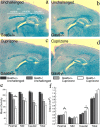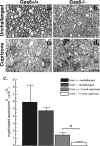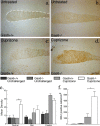Gas6 deficiency increases oligodendrocyte loss and microglial activation in response to cuprizone-induced demyelination
- PMID: 18480276
- PMCID: PMC3844801
- DOI: 10.1523/JNEUROSCI.1180-08.2008
Gas6 deficiency increases oligodendrocyte loss and microglial activation in response to cuprizone-induced demyelination
Abstract
The TAM family of receptor protein tyrosine kinases comprises three known members, namely Tyro3, Axl, and Mer. These receptors are widely expressed in the nervous system, including by oligodendrocytes, the cell type responsible for myelinating the CNS. We examined the potential role of the TAM family and of their principle cognate ligand, Gas6 (growth arrest gene 6), in modulating the phenotype of the cuprizone model of demyelination. We found that the expression profiles of Axl, Mer, and Gas6 mRNA were increased in the corpus callosum in a temporal profile correlating with the increased migration and proliferation of microglia/macrophages in this model. In contrast, expression of Tyro3 decreased, correlating with the loss of oligodendrocytes. Gas6 both promoted in vitro survival of oligodendrocytes (39.3 +/- 3.1 vs 11.8 +/- 2.4%) and modulated markers of activation in purified cultures of microglia (tumor necrosis factor alpha mRNA expression was reduced approximately 48%). In Gas6-/- mice subjected to cuprizone-challenge, demyelination was greater than in control mice, within the rostral region of the corpus callosum, as assessed by luxol fast blue staining (myelination reduced by 36%) and by ultrastructural analysis. An increased loss of Gst-pi (glutathione S-transferase-pi)-positive oligodendrocytes was also identified throughout the corpus callosum of Gas6-/- mice. Microglial marker expression (ionized calcium-binding adapter molecule 1) was increased in Gas6-/- mice but was restricted to the rostral corpus callosum. Therefore, TAM receptor activation and regulation can independently influence both oligodendrocyte survival and the microglial response after CNS damage.
Figures









Similar articles
-
Gas6 increases myelination by oligodendrocytes and its deficiency delays recovery following cuprizone-induced demyelination.PLoS One. 2011 Mar 10;6(3):e17727. doi: 10.1371/journal.pone.0017727. PLoS One. 2011. PMID: 21423702 Free PMC article.
-
Loss of Gas6 and Axl signaling results in extensive axonal damage, motor deficits, prolonged neuroinflammation, and less remyelination following cuprizone exposure.Glia. 2017 Dec;65(12):2051-2069. doi: 10.1002/glia.23214. Epub 2017 Sep 19. Glia. 2017. PMID: 28925029 Free PMC article.
-
The therapeutic effect of GAS6 in remyelination is dependent upon Tyro3.Glia. 2024 Aug;72(8):1392-1401. doi: 10.1002/glia.24534. Epub 2024 Apr 4. Glia. 2024. PMID: 38572807
-
TAM Receptor Pathways at the Crossroads of Neuroinflammation and Neurodegeneration.Dis Markers. 2019 Sep 15;2019:2387614. doi: 10.1155/2019/2387614. eCollection 2019. Dis Markers. 2019. PMID: 31636733 Free PMC article. Review.
-
The role of TAM family receptors and ligands in the nervous system: From development to pathobiology.Pharmacol Ther. 2018 Aug;188:97-117. doi: 10.1016/j.pharmthera.2018.03.002. Epub 2018 Mar 4. Pharmacol Ther. 2018. PMID: 29514053 Free PMC article. Review.
Cited by
-
TAM receptor signaling in immune homeostasis.Annu Rev Immunol. 2015;33:355-91. doi: 10.1146/annurev-immunol-032414-112103. Epub 2015 Jan 14. Annu Rev Immunol. 2015. PMID: 25594431 Free PMC article. Review.
-
Altered circulating GDF-15 level predicts sex hormone imbalance in males with major depressive disorder.BMC Psychiatry. 2023 Jan 12;23(1):28. doi: 10.1186/s12888-023-04527-z. BMC Psychiatry. 2023. PMID: 36635686 Free PMC article.
-
miRNAs in Microglia: Important Players in Multiple Sclerosis Pathology.ASN Neuro. 2021 Jan-Dec;13:1759091420981182. doi: 10.1177/1759091420981182. ASN Neuro. 2021. PMID: 33517686 Free PMC article. Review.
-
Microglial phagocytosis of live neurons.Nat Rev Neurosci. 2014 Apr;15(4):209-16. doi: 10.1038/nrn3710. Nat Rev Neurosci. 2014. PMID: 24646669 Review.
-
Microglial phagocytosis of single dying oligodendrocytes is mediated by CX3CR1 but not MERTK.bioRxiv [Preprint]. 2023 Dec 12:2023.12.11.570620. doi: 10.1101/2023.12.11.570620. bioRxiv. 2023. Update in: Cell Rep. 2024 Jul 23;43(7):114385. doi: 10.1016/j.celrep.2024.114385. PMID: 38168326 Free PMC article. Updated. Preprint.
References
-
- Angelillo-Scherrer A, de Frutos P, Aparicio C, Melis E, Savi P, Lupu F, Arnout J, Dewerchin M, Hoylaerts M, Herbert J, Collen D, Dahlback B, Carmeliet P. Deficiency or inhibition of Gas6 causes platelet dysfunction and protects mice against thrombosis. Nat Med. 2001;7:215–221. - PubMed
-
- Arnett HA, Mason J, Marino M, Suzuki K, Matsushima GK, Ting JP. TNF alpha promotes proliferation of oligodendrocyte progenitors and remyelination. Nat Neurosci. 2001;4:1116–1122. - PubMed
-
- Arnett HA, Hellendall RP, Matsushima GK, Suzuki K, Laubach VE, Sherman P, Ting JP. The protective role of nitric oxide in a neurotoxicant-induced demyelinating model. J Immunol. 2002;168:427–433. - PubMed
-
- Barnett MH, Prineas JW. Relapsing and remitting multiple sclerosis: pathology of the newly forming lesion. Ann Neurol. 2004;55:458–468. - PubMed
Publication types
MeSH terms
Substances
Grants and funding
LinkOut - more resources
Full Text Sources
Other Literature Sources
Molecular Biology Databases
Research Materials
Miscellaneous
